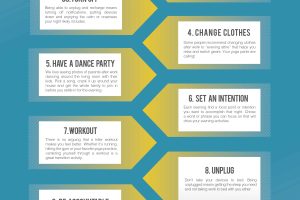Living Well: A Guide to Achieving a Healthy Work-Life Balance

Defining Work-Life Balance
Work-life balance can be defined as the equilibrium between personal life and professional responsibilities. It is about finding a healthy compromise where neither side consumes all of an individual’s time and energy. Everyone has different perceptions of balance; for some, it may mean working regular hours to spend evenings with family, while for others, it might involve flexibly blending work with personal pursuits. For instance, consider Sarah, a marketing manager and mother of two. Sarah thrives on the hustle and bustle of her job but knows the importance of being present at her children’s school events. By learning how to reprioritize tasks and delegate work, she successfully creates a space for quality family time without the overwhelming stress of work encroaching on her personal joys.
- Living Well: A Guide to Achieving a Healthy Work-Life Balance
- Defining Work-Life Balance
- Importance of Achieving a Healthy Work-Life Balance
- Understanding the Impact of Work-Life Balance
- Effects on Physical Health
- Effects on Mental Well-Being
- Tips for Achieving Work-Life Balance
- Setting Boundaries
- Time Management Strategies
- Incorporating Self-Care into Your Routine
- Prioritizing Sleep
- Practicing Mindfulness
- Building Support Systems
- Seeking Help from Family and Friends
- Utilizing Employee Assistance Programs
Importance of Achieving a Healthy Work-Life Balance
Achieving a healthy work-life balance is not just beneficial; it is essential for overall well-being. Here’s why:
- Increased Productivity: Individuals who maintain a balance between their work and personal lives generally report higher productivity levels. They arrive at work refreshed and motivated, leading to better outcomes.
- Enhanced Relationships: Balancing work responsibilities allows for more quality time spent with loved ones. This can strengthen bonds and foster a supportive environment both at home and work.
- Reduced Stress: A well-balanced lifestyle can help reduce stress and prevent burnout. When work consumes all the time, stress levels rise, impacting both mental and physical health.
- Improved Health: People who invest time in both work and personal endeavors typically experience better physical health. Regular exercise, social interaction, and sleep contribute positively to their health.
By recognizing the significance of work-life balance, individuals can make conscious efforts to carve out time for themselves, their families, and their personal interests without feeling guilty about their professional commitments. It’s a journey worth embarking on—one that leads to a fulfilling and enriched life.
Understanding the Impact of Work-Life Balance
Effects on Physical Health
The significance of work-life balance reverberates profoundly through our physical health. When individuals excessively focus on their professional responsibilities, they often neglect their physical well-being. This misalignment can lead to serious health concerns over time. For example, consider John’s scenario—a software developer who frequently skips lunch to complete projects and cancels evening workouts due to looming deadlines.
- Common physical health issues stemming from poor work-life balance include:
- Increased risk of heart disease: Stress from overwork can elevate blood pressure and lead to cardiovascular issues.
- Weakened immune system: Chronic stress can impair immunity, making one more susceptible to illness.
- Fatigue: Extended hours without adequate rest can lead to chronic fatigue, affecting work performance and daily life.
On the flip side, prioritizing balance enables individuals like John to integrate regular exercise, nutritious meals, and adequate rest into their routines, thereby promoting optimal health.
Effects on Mental Well-Being
The mental well-being of an individual is intricately linked to how well they manage their work-life balance. A persistent imbalance can lead to heightened stress levels, anxiety, and even depression. Take Lisa, for example, who found herself overwhelmed juggling a demanding job with family responsibilities. She discovered that this imbalance not only affected her mood but also her overall outlook on life.
- The mental ramifications of poor work-life balance can manifest in various ways:
- Anxiety and stress: Constant pressure to perform at work can lead to chronic anxiety.
- Emotional exhaustion: Lack of downtime can deplete emotional resources, making it harder to cope with daily challenges.
- Increased irritability: A short fuse and heightened frustrations can strain relationships with coworkers and family members.
Conversely, achieving a healthy work-life balance can bolster mental health, fostering improved focus, resilience, and joy in both personal and professional domains. By understanding these impacts, individuals are better equipped to prioritize their well-being and cultivate a fulfilling lifestyle, ultimately leading to both physical and mental wellness.
Tips for Achieving Work-Life Balance
Setting Boundaries
To foster a healthy work-life balance, the very first step is setting boundaries. It’s essential to draw a line between your work and personal time to prevent one from bleeding into the other. Consider Mark’s experience—a project manager who found himself checking emails late into the night, often missing out on family dinners. After realizing the negative impact on his relationships, Mark decided to implement a few simple yet effective boundaries:
- Create a designated workspace: Establish a specific area in your home for work. This physical separation helps transition your mindset between work and personal life.
- Specify work hours: Clearly communicate your work hours to your coworkers and family. For instance, Mark set a firm rule to not answer work emails or calls after 6 p.m.
- Learn to say no: It’s okay to decline additional responsibilities that may encroach on your personal time. This can prevent overwhelm and ensure you’re focused on what matters most.
By sticking to these boundaries, Mark not only improved his family time but also found that he was more focused and productive during work hours.
Time Management Strategies
Alongside setting boundaries, honing time management strategies is crucial for achieving work-life balance. Having a structured approach to time can alleviate stress and create more space for personal interests and family.
- Prioritize tasks using lists: Create a daily or weekly to-do list ranking tasks by importance. Tackle high-priority items first, allowing lower-priority tasks to be managed flexibly.
- Utilize tools: Consider using calendars or apps that help manage time effectively. For example, tools like Trello or Google Calendar can help in organizing tasks and deadlines.
- Break tasks into smaller chunks: Instead of viewing large projects as daunting, break them down into smaller, manageable pieces. This can simplify your workload and provide a sense of accomplishment as you complete each section.
By adopting these time management strategies, individuals can enjoy a more structured day, reduce stress levels, and make room for activities that rejuvenate them. Ultimately, implementing boundaries and effective time management not only increases productivity but also ensures a more gratifying work-life balance.
Incorporating Self-Care into Your Routine
Prioritizing Sleep
In the pursuit of a healthy work-life balance, incorporating self-care practices is vital, and one of the most essential is prioritizing sleep. Quality rest is not just a luxury; it’s a necessity that significantly impacts overall well-being. Unfortunately, many individuals, like Emma, a busy executive, often sacrifice sleep for work deadlines or personal commitments. Emma realized that her late nights left her feeling drained and unfocused. To counteract this, she started setting a consistent bedtime to ensure she was getting around 7-8 hours of quality sleep. Here are some strategies that helped her enhance her sleep routine:
- Establish a wind-down routine: Engaging in calming activities like reading or gentle stretching before bed can signal your body that it’s time to rest.
- Limit screen time: Reducing exposure to screens an hour before bedtime can improve sleep quality. Emma enforced a no-screen policy in her bedroom, which made a noticeable difference in her ability to fall asleep.
- Create a restful environment: Keeping the bedroom cool, dark, and quiet fosters better sleep. Investing in blackout curtains and white noise machines can enhance the sleep experience.
By making sleep a priority, Emma discovered that her energy levels soared, ultimately leading to improved performance at work and fulfilling interactions at home.
Practicing Mindfulness
Another crucial aspect of self-care is practicing mindfulness. In a world filled with distractions and constant demands, mastering mindfulness can help individuals like Emma recenter themselves. Mindfulness is about staying present and fully engaging in the moment, alleviating stress and promoting emotional well-being. To incorporate mindfulness into daily routines, consider these approaches:
- Mindful breathing exercises: Taking a few minutes each day to focus on deep breathing can reduce anxiety and clarify thoughts. For Emma, a five-minute breathing exercise during her lunch break became a game-changer.
- Meditation: Even just ten minutes of meditation can lead to profound benefits. Many apps, like Headspace or Calm, provide guided meditations that are perfect for beginners.
- Practicing gratitude: Keeping a gratitude journal can shift focus away from stressors and enhance overall positivity. Emma found that writing down three things she was grateful for each evening helped shift her mindset.
By integrating sleep and mindfulness practices into her daily routine, Emma achieved greater clarity and resilience, ultimately making her work-life balance more sustainable and rewarding. Incorporating self-care isn’t merely an add-on; it’s a fundamental aspect of leading a balanced and fulfilling life.
Building Support Systems
Seeking Help from Family and Friends
As people navigate the complexities of work and personal life, building a solid support system becomes essential. One of the most accessible sources of support comes from family and friends. These individuals can provide emotional support, practical help, and regular encouragement, making it easier to maintain a healthy work-life balance. For instance, take Sarah, a young professional striving to balance her demanding job with her responsibilities as a single parent. She often felt overwhelmed juggling deadlines and homework help. Recognizing the importance of support, she reached out to her family and friends to establish a more robust network. Here are some of the ways she did it:
- Communicating needs clearly: Sarah organized a monthly family meeting where she outlined her work schedule and shared specific instances where she could use extra help, such as babysitting or grocery shopping.
- Creating a buddy system: She teamed up with close friends who also had children, swapping babysitting duties to give each other the much-needed downtime.
- Celebrating together: Taking time to celebrate small victories, whether sharing a meal or simply enjoying an evening together, reminded her that she wasn’t alone in her struggles.
By leveraging her support system, Sarah cultivated stronger relationships while significantly reducing her stress levels.
Utilizing Employee Assistance Programs
In addition to relying on personal relationships, individuals can benefit immensely from utilizing Employee Assistance Programs (EAPs) offered by many organizations. EAPs are designed to help employees manage personal issues that may impact their work or overall well-being. For instance, consider how Mark, a corporate lawyer, turned to his company’s EAP during a particularly stressful period. His experience unveiled a variety of resources that could assist him:
- Counseling services: Many EAPs provide access to confidential counseling sessions where employees can discuss work-related stress, family issues, or mental health concerns.
- Work-life balance resources: EAPs often offer workshops and materials on stress management, time management, and setting boundaries, equipping employees like Mark with practical tools.
- Legal and financial advice: Sometimes work-life balance struggles stem from external pressures. EAPs can connect individuals to experts who provide guidance on financial planning or legal matters.
By tapping into the resources available through EAPs, Mark not only found coping mechanisms but also regained control over his work-life balance, enhancing his productivity and mental clarity. Building support systems, whether through family, friends, or workplace programs, is essential. It fosters resilience and empowers individuals to face the challenges of balancing work and personal life effectively.





